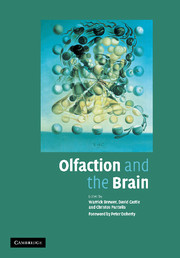Book contents
- Frontmatter
- Contents
- Foreword
- Preface
- List of Contributors
- Section I Neurology, Neurophysiology and Neuropsychology: Olfactory Clues to Brain Development and Disorder
- Section II Social Functioning: Role of Evolution, Genetics and Gender
- Section III Assessment and Disorders of Olfaction
- 13 Assessment of Olfaction
- 14 Olfactory Impairment in Neuropsychiatric Disorders
- 15 Olfaction in Parkinsonian Syndromes
- 16 Olfaction in Psychosis
- 17 Olfactory Hallucinations
- 18 Delusions of Body Malodour: The Olfactory Reference Syndrome
- Index
- Plate section
- References
15 - Olfaction in Parkinsonian Syndromes
from Section III - Assessment and Disorders of Olfaction
Published online by Cambridge University Press: 17 August 2009
- Frontmatter
- Contents
- Foreword
- Preface
- List of Contributors
- Section I Neurology, Neurophysiology and Neuropsychology: Olfactory Clues to Brain Development and Disorder
- Section II Social Functioning: Role of Evolution, Genetics and Gender
- Section III Assessment and Disorders of Olfaction
- 13 Assessment of Olfaction
- 14 Olfactory Impairment in Neuropsychiatric Disorders
- 15 Olfaction in Parkinsonian Syndromes
- 16 Olfaction in Psychosis
- 17 Olfactory Hallucinations
- 18 Delusions of Body Malodour: The Olfactory Reference Syndrome
- Index
- Plate section
- References
Summary
Introduction
Interest in the smell dysfunction of patients with extrapyramidal disorder has increased in recent years with the recognition that most patients with Idiopathic Parkinson's Disease (IPD) are hyposmic and the possibility that olfactory disorder might be an initial event preceding the classical signs of the disease. This has been aided by 18F-dopa positron emission spectroscopy (PET) scan and latterly by the less expensive dopamine transporter scan (DATScan) technique, both of which image cerebral dopamine distribution and raise the possibility of presymptomatic diagnosis. Thus, olfactory disorder can act as a biomarker of a pending disease and may afford the possibility of neuroprotective therapy.
Olfactory testing
Most clinicians do not enquire about olfaction let alone perform any tests of it. At least one-third of the subjects with hyposmia are unaware of their defect (Hawkes et al., 1997) and others complain of loss of taste instead: thus, it is insufficient simply to ask a patient about their sense of smell. Local nasal disease has to be excluded by clinical examination, endoscopy and ideally computed tomography/magnetic resonance imaging (CT/MRI), but a useful clue is that when anosmia is intermittent, the problem is probably conductive i.e. air cannot reach the olfactory neurons in the nose. Conversely, continual anosmia is characteristic of sensorineural loss.
Age has a profound effect on smell function and our recent analysis of smell identification score (Hawkes et al., 2005) showed that ageing effects start at 36 years (Figure 15.1).
Keywords
- Type
- Chapter
- Information
- Olfaction and the Brain , pp. 279 - 295Publisher: Cambridge University PressPrint publication year: 2006



